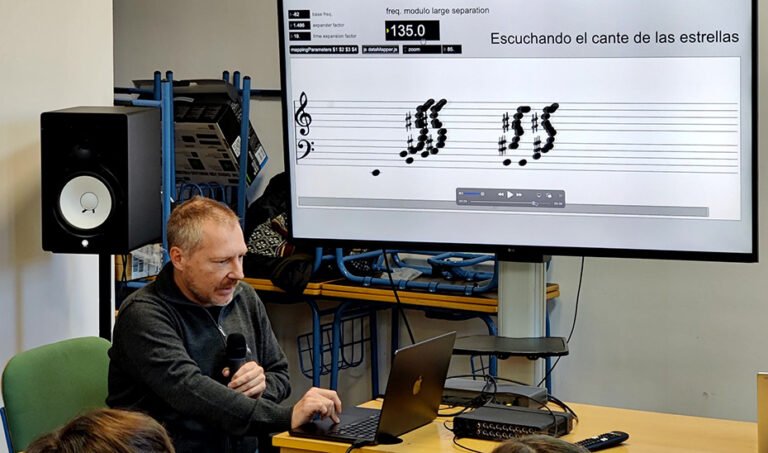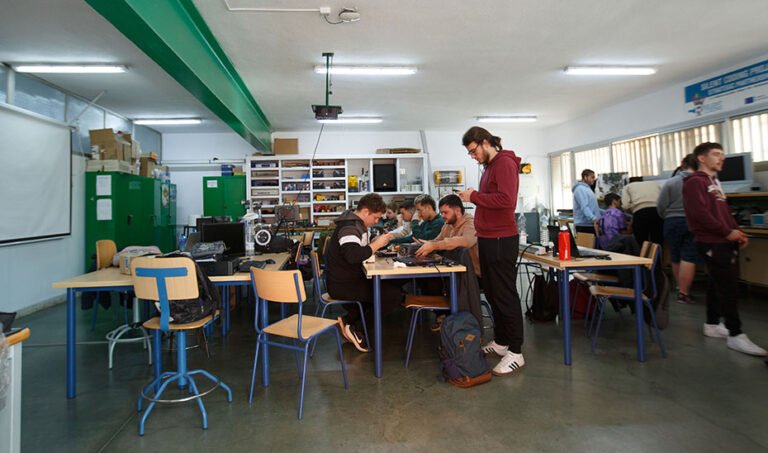
The Department of Culture and Sports has organized over fifty activities to celebrate International Museum Day in the centers it manages in the eight provinces of Andalusia, with the aim of conveying to the public the fundamental role that these cultural institutions play in society. The commemoration, celebrated every 18th of May since 1977, is organized by the International Council of Museums and this year has the theme ‘The future of museums in constantly changing communities’, inviting us to «reimagine» the role of these spaces as «essential, innovative connectors and guardians of cultural identity.»
In light of this commemoration, the Minister of Culture and Sports, Patricia del Pozo, has emphasized that Andalusian museums are «a great space for social transformation and intercultural encounters» in the autonomous community, places where citizens have the opportunity to «reconnect with a past that, by knowing it, will allow new perspectives to emerge to move forward and face the future.»
The activities, to be held around the upcoming 18th of May, have been designed to pique the interest of the whole family and different types of audiences, including workshops on Roman perfumes in Itálica, guided tours to non-visitable areas of the Jaén Museum, conferences on music and painting at the Málaga Museum, and ‘escape room’ games like the one organized by the Bellas Artes in Córdoba. In essence, a wide range of activities that also include concerts and dance performances that will take place in museum centers, ensembles, and archaeological sites in the eight provinces, as well as in institutions under the Department of Culture and Sports.
In Almería, the Monumental Complex of the Alcazaba has organized a workshop-visit on the 18th called ‘My history, my culture: exploring the Alcazaba’, aimed at a family audience, offering a tour of the site to remember history and contemplate where society wants to go.
On the other hand, the Almería Museum has prepared up to four workshops, three for schoolchildren and one for seniors. The first is ‘Writing supports and tools’, where schoolchildren will learn and experiment with different writing materials on May 14, ‘Experience’, focused on archaeology, on May 16, and ‘The origin of our writing’, a journey through alphabets from ancient times to the present day, on May 18. On the 21st, the workshop for seniors ‘Culture served in clay, the Andalusian tableware’, on the gastronomic heritage of that historical period, will be held.
Additionally, the Andalusian Photography Center (CAF) proposes for the 18th ‘A photographic adventure’, a family activity that invites the public to take a photographic report of the experience of visiting this space, providing attendees with an easy-to-use digital camera.
The Cadiz Museum hosts two workshops for children. The first will take place on May 13 and will focus on making personalized stickers from pieces in its collection using the language of comics and contemporary illustration tools. The second, on May 18, proposes the illustration of jewelry inspired by Phoenician art. Additionally, on the 17th, in collaboration with the Professional Dance Conservatory María Gallardo, there will be a show with short choreographies dialoguing with the museum’s artworks.
Painting Roman togas in Córdoba
In Córdoba, the Archaeological Complex of Madinat Al-Zahra presents on May 18 a didactic guided tour of the archaeological site, highlighting the research, restoration, conservation, and dissemination work being carried out.
The Archaeological Museum of Córdoba has organized for May 17 the workshop ‘Iberian-Roman pigments and fabrics’, where children can design and paint their own Roman togas and mantles using different types of plant-based materials. In addition, on May 18, a conference will be given by the archaeologist and coordinator of the Ategua site, María del Camino Fuertes Santos, entitled ‘About a sculpture of a ram found at the Ategua site, Córdoba’.
The Córdoba Museum of Fine Arts offers on the 18th for a general audience an ‘escape room’ game titled ‘The essence of the Museum’, combining a tour of the center’s collection with contemporary works from the ‘Double Tempo’ program and a visit to the Romero de Torres family patio, open for the Patios festival.
At the C3A, a workshop for families will be held on May 17 around the exhibition ‘Learning by Ear. Silent singers; wandering apprentices’ by Cristina Mejías. This will be followed on the 18th by another workshop for teenagers, including a guided tour of the exhibition ‘My eyes hurt from looking without seeing’ by Ana Segovia. Finally, on May 23, the deputy director of this center under the Department of Culture and Sports, Gilberto González, will give a guided tour of the exhibition ‘Plots and fictions’, about the photographic collection of the Andalusian Center for Contemporary Art.
The Archaeological Museum of Granada has organized up to eight activities starting on May 16 with a singing and guitar recital, organized in collaboration with the Higher Conservatory of Music Victoria Eugenia of the city, featuring mezzo-soprano Andrea Sánchez-Lafuente and guitarist Miguel Ángel Maldonado.
On May 17, the scavenger hunt ‘The museum challenge’ will be held, where the whole family can participate in challenges and questions that will lead them to discover the main museums of Andalusia. On the same day, for an adult audience, a guided tour of the museum’s permanent exhibition will be organized by the archaeologist Rafael Pedregosa Megías. That same day, you can also enjoy a concert by the ‘Little Voices of the Alhambra’ Choir, directed by Myriam Gálvez.
On May 18, the Museum will organize a theatrical visit that will review the history and legends surrounding the Casa de Castril, the Renaissance palace that houses the Archaeological Museum. It will be doña Elvira, daughter of Hernando de Zafra -secretary of the Catholic Monarchs- who will guide the tour. Two days later, on May 20, the Saxophone Ensemble of the Victoria Eugenia Conservatory will present ‘Sax at the Museum’, a journey from the Baroque to avant-garde music. The day’s activities will be completed by a conference by Soledad Gómez Vilches and a round table discussion on Museum Day, ‘The future of museums in constantly changing communities’.
Finally, on May 22, the Archaeological Museum will host the concert ‘From the Alpujarras to Arafat. Sacred Songs between the East and the West’, as part of the Early Music Festival of the city.
Nasrid medicine at the Alhambra
On the other hand, the Museum of Fine Arts of Granada proposes on May 18 the poetry and music show ‘Landscapes of Memory in Granada’, by the minstrel and ballad singer Javier Tárraga and the Arab lute player and garnatí mandola Mostafá Bakkali.
The Casa de los Tiros Museum hosts on May 17 the concert ‘Umbráfono’, a musical research project that uses the transformation of light into sound created by the musician and graphic artist Enrique del Castillo. The next day, the center presents the family workshop ‘Past and future at the Casa de los Tiros Museum’, providing information about some pieces from the city’s past and reflecting on how children see the future of museums, in addition to creating a time capsule.
The Alhambra has organized on May 17 and 18, through its educational program, the activity ‘The essence of care’, proposing that participants learn and reflect on how certain aspects of Nasrid medicine have survived to this day, remaining alive in the community’s memory.
The Huelva Museum organizes three workshops for families to commemorate the event. The first two will take place on May 17, ‘Art in Prehistory’, focusing on cave art, and ‘Rituals in Prehistory’, about the songs, rites, and offerings of ancient civilizations. The activities will be completed on May 18 with ‘I was at La Joya’, a creative writing workshop for the exhibition ‘La Joya. Life and eternity in Tartessos’, recently inaugurated at this museum.
In Jaén, the Linares Archaeological Museum hosts the temporary micro-exhibition ‘Fallen Deities: Illuminated in Cástulo’, open to the public from May 16 to September 14, dedicated to glyptics or the art of engraving hard stones. On May 18, a concert by the flute trio ‘Eutepre’ will be held.
On the other hand, the Úbeda Archaeological Museum presents on May 16 ‘What a mess of an exhibition!’, a performance by the Municipal School of Theater Ricardo Iniesta, involving people with and without functional diversity, where a group of clowns gives a very particular guided tour of the exhibition. This is complemented on the 18th by the concert ‘Musical walk through the museum’, with Renaissance music in various rooms.
The Museum of Arts and Popular Customs of Alto Guadalquivir proposes for May 18 a theatrical visit titled ‘The puppeteers of the castle’, where visitors will learn about the rooms of the Castle of Yedra through the stories of some very peculiar inhabitants.
The hidden side of the Jaén Museum
On May 16, activities will begin at the Jaén Museum, with a music concert by the Coral Aída, inspired by different European cultural traditions. The next day, an oral storytelling session titled ‘The magic pencil’, aimed at children, will be followed by a violin and guitar concert featuring pieces by Bach, Bizet, and Liszt. The day will conclude with a guided tour called ‘Hidden Museum’, where visitors can access spaces such as warehouses and restoration areas.
The Iberian Museum also joins the celebration with two days of activities. On May 17, a theatrical visit, ‘Mystery in the Museum’, aimed at a family audience, will illustrate visitors in this Iberian culture in a comedy and mystery style, accompanied by a flute trio concert. The following day, the proposals will continue with a guided tour of the museum’s exhibitions and a role-playing game workshop for a family audience, called ‘Merchant Ship Simulator’, presenting visitors with different aspects of Mediterranean civilizations.
In Málaga, the Antequera Dolmens Archaeological Complex will kick off the event on May 14 with the workshop ‘Open-air Prehistory Museum’, aimed at primary school students. The activities will continue on the 15th with ‘Music and Dance in Prehistory’, where users of the Mental Health Area of the Antequera Hospital will participate, and on the 17th with the family workshop ‘Prehistoric Saturday. Musical instruments and dances in Prehistory’. Finally, on the 18th, inclusive thematic visits to the two museum exhibitions of the Site will take place.
The Málaga Museum has prepared the guided tour ‘Pharaohs in the Málaga Museum’, which will cover on May 16 a review of pieces in its collection related to Egypt. On the same day, the professor at the University of Málaga, María José de la Torre Molina, will give a lecture ‘Sound postcards of Spain: music and dance in the painting of the Málaga Museum’.
The activities in this space will conclude on the 17th with the workshop ‘Archaeodrome of the Málaga Museum’, where the youngest, accompanied by an adult, will be able to experience how archaeologists work in a simulated site. In addition, from May 13 to 18, the exhibition ‘Come to my house’ organized by the Andalusian Institute of Plastic and Visual Arts will be on display in the Alcazabilla Hall of this space, showing how five-year-old children have imagined their ideal museum.
Roman perfumes workshop in Itálica
The Italica Archaeological Complex, in the town of Santiponce, Seville, has organized two workshops for May 18: ‘Hadrian in Italica’, for children to learn about his figure by making a wooden bust of the emperor, and another workshop for adults, focused on making solid perfumes from aromas used in ancient Rome.
The Museum of Arts and Popular Customs will present on May 18 a guided tour of the exhibition ‘Cultures of the sea. Lives on the Andalusian coast’, on the cultural, historical, and social richness of the fishing communities in the region. Additionally, on the same day, the center will host the traditional tuna cutting by specialists, i.e., the traditional butchering of this species done in the
FUENTE





